Optimizing Large-Scale Inorganic Processes: Model-Based Digital Design of RH-DS Apparatus
Abstract
1. Introduction
- The more accurate determination of the product lifecycle;
- A reduction in costs associated with building prototype installations (or multiple prototype installations), which can also be time-consuming;
- The ability to simulate experiments that, due to safety concerns or practical limitations, cannot be conducted at the laboratory or industrial scale;
- The real-time monitoring, analysis, and forecasting of potential issues, which supports critical decision-making during emergencies and helps to reduce the risk of failures and losses;
- The optimization of various components within industrial plants, including process parameters and raw material consumption indicators, across the entire process scale, which may consist of multiple interconnected units.
- (a)
- Upper section (RH): This section, known as the preheater of the distiller (reschofer), is where volatile ammonium salts (such as ammonium carbonates) decompose. It is typically configured as a packed scrubber divided into segments or as a bubble-cap tray apparatus. The design choice influences the efficiency of heat and mass transfer within the section.
- (b)
- Lower section (DS): This section, referred to as the distiller, is where the recovery of ammonia from the remaining salts occurs. It is usually designed as a bubble-cap tray apparatus to facilitate the separation process.
2. Raw Materials and Modeling Approach
2.1. Post-Filtration Liquid
2.2. Lime Milk
2.3. Steam
2.4. Modeling Approach
2.4.1. Chemical Reactions
2.4.2. Mass and Heat Transfer Between Gas and Liquid Phases
2.4.3. Ammonia Regeneration Process in RH-DS Units
3. Development of RH-DS Models in gProms Process 2023.2.0 Software Environment
- The construction of digital twins of processes using industry-leading, high-accuracy models;
- Calibration based on experimental or industrial data using state-of-the-art parameter estimation and model validation tools;
- Global system analysis for the rapid exploration of the decision space and quantification of risk;
- Multidimensional optimization to determine an optimal solution.
4. Model Optimization Techniques
- (1)
- Large-scale mathematical optimization (including mixed-integer nonlinear programming, MINLP), where multiple decision variables are altered simultaneously to maximize or minimize (typically economic) objective functions while ensuring that constraints regarding equipment, process, and product quality are considered. This enables the simultaneous determination of optimal values for numerous design and operational variables, taking into account all relevant factors. The use of MINLP primarily occurs during the process design phase (both at the level of the entire process in a production plant and for individual installations or single reactors) by determining the optimal combination of discrete decisions (e.g., equipment selection, operating modes) and continuous variables (e.g., flow rates, temperatures). In the subsequent stage, digital modeling programs use MINLP for operational control to define optimal control strategies for operational systems in real time. For example, it can optimize parameters such as production rates or energy consumption, taking into account constraints imposed by the physical system or external factors. In addition, MINLP is used to model complex behaviors in production systems, such as nonlinear relationships between variables or decisions that involve multiple relationships continuously, and it can be applied to optimize maintenance schedules and predict equipment failures. MINLP algorithms can be used for real-time decision-making or can be used in digital twin simulations to optimize energy use and resource allocation.
- (2)
- Global system analysis (GSA) to systematically explore the decision space of the process by calculating the impact of variability in model input data (e.g., values of key design parameters) or uncertainty in model parameters (e.g., experimentally determined kinetic parameters) that affect process KPIs. GSA activities include conducting sensitivity and uncertainty analyses to minimize technological risks [46,47].
- -
- Parametric studies involve conducting a large number of simulations to analyze the impact of various factors. GSA examines systems holistically, without focusing on individual components, correlating interrelationships, feedback loops, and dynamic interactions among elements (Figure 3).
- -
- Uncertainty analysis considering uncertainties in factors such as parametric, structural, input, or scenario uncertainties to determine the probability of responses using Monte Carlo simulations, sensitivity analyses, probabilistic methods, or scenario analyses (Figure 4).
5. Results
6. Conclusions and Summary
Author Contributions
Funding
Data Availability Statement
Conflicts of Interest
References
- Kamath, V.; Morgan, J.; Ali, M.I. Industrial IoT and digital twins for a smart factory: An open-source toolkit for application design and benchmarking. In Proceedings of the 2020 Global Internet of Things Summit(GioTS), Dublin, Ireland, 3 June 2020; pp. 1–6. [Google Scholar] [CrossRef]
- Lu, Y.; Liu, C.; Kevin, I.; Wang, K.; Huang, H.; Xu, X. Digital Twin-driven smart manufacturing: Connotation, reference model, applications and research issues. Robot. Comput. Integr. Manuf. 2020, 61, 101837. [Google Scholar] [CrossRef]
- Negri, E.; Fumagalli, L.; Macchi, M. A Review of the Roles of Digital Twin in CPS-based Production Systems. Procedia Manuf. 2017, 11, 939–948. [Google Scholar] [CrossRef]
- Damjanovic-Behrendt, V.; Behrendt, W. An open source approach to the design and implementation of Digital Twins for Smart Manufacturing. Int. J. Comput. Integr. Manuf. 2019, 32, 366–384. [Google Scholar] [CrossRef]
- Augustine, P. Chapter Four-The industry use cases for the Digital Twin idea. Adv. Comput. 2020, 117, 79–105. [Google Scholar] [CrossRef]
- Qi, Q.; Tao, F.; Hu, T. Enabling technologies and tools for digital twin. J. Manuf. Syst. 2021, 58, 3–21. [Google Scholar] [CrossRef]
- Shafto, M.; Conroy, M.; Doyle, R.; Glaessgen, E.; Kemp, C.; LeMoigne, J.; Wang, L. Draft modeling, simulation, information technology & processing roadmap. Technol. Area 2010, 11, 1–32. [Google Scholar]
- Rosen, R.; Von Wichert, G.; Lo, G.; Bettenhausen, K.D. About the importance of autonomy and digital twins for the future of manufacturing. IFAC-PapersOnLine 2015, 48, 567–572. [Google Scholar] [CrossRef]
- Boschert, S.; Rosen, R. Digital twin—The simulation aspect. In Mechatronic Futures; Springer: Cham, Switzerland, 2016. [Google Scholar] [CrossRef]
- Zuehlke, D. SmartFactory–from Vision to Reality in Factory Technologies. IFAC Proc. Vol. 2008, 41, 14101–14108. [Google Scholar] [CrossRef]
- Maulshree, S.; Fuenmayor, E.; Hinchy, E. Digital Twin: Origin to Future. Appl. Syst. Innov. 2021, 4, 36. [Google Scholar] [CrossRef]
- Saddik, E.A. Digital twins: The convergence of multimedia technologies. IEEE Multimed. 2018, 25, 87–92. [Google Scholar] [CrossRef]
- Schluse, M.; Rossmann, J. From simulation to experimentable digital twins: Simulation-based development and operation of complex technical systems. In Proceedings of the 2016 IEEE International Symposium on Systems Engineering (ISSE), Edinburgh, UK, 3–5 October 2016; pp. 1–6. [Google Scholar] [CrossRef]
- Tuegel, E. The airframe digital twin: Some challenges to realization. In Proceedings of the 53rd AIAA/ASME/ASCE/AHS/ASC Structures, Structural Dynamics and Materials Conference 20th AIAA/ASME/AHS Adaptive Structures Conference 14th AIAA, Honolulu, HI, USA, 23–26 July 2012; p. 1812. [Google Scholar] [CrossRef]
- Kraft, E.M. The air force digital thread/digital twin-life cycle integration and use of computational and experimental knowledge. In Proceedings of the 54th AIAA Aerospace Sciences Meeting, San Diego, CA, USA, 4–8 January 2016; p. 0897. [Google Scholar] [CrossRef]
- Adamenko, D.; Kunnen, S.; Nagarajah, A. Comparative Analysis of Platforms for Designing a Digital Twin. Adv. Des. Simul. Manuf. III 2020, 1, 3–12. [Google Scholar] [CrossRef]
- Tao, F.; Zhang, M.; Liu, Y. Digital twin driven prognostics and health management for complex equipment. CIRP Ann. 2018, 67, 169–172. [Google Scholar] [CrossRef]
- Digital Twin: 5 Challenges for 7 Benefits. 2019. Available online: https://www.ingenium-magazine.it/en/digital-twin-6-sfide-per-7-benefici/ (accessed on 12 October 2020).
- Gagné, M.R. Digital Twins, Another Reason to Worry About the IoT and Data Security. Available online: https://irishtechnews.ie/digital-twins-iot-and-data-security/ (accessed on 12 October 2020).
- Goasduff, L. Confront Key Challenges to Boost Digital Twin Success. Available online: https://gartner.com/smarterwithgartner/confront-key-challenges-to-boost-digital-twin-success (accessed on 12 October 2020).
- Opoku, D.; Perera, S.; Osei-Kyei, R. Digital twin application in the construction industry: A literature review. J. Build. Eng. 2021, 40, 102726. [Google Scholar] [CrossRef]
- Hofmeister, M.; Rihm, S. Dynamic knowledge graph applications for augmented built environments through “The World Avatar”. J. Build. Eng. 2024, 91, 109507. [Google Scholar] [CrossRef]
- Karacan, S.; Hapoǧlu, H.; Alpbaz, M. Application of optimal adaptive generalized predictive control to a packed distillation column. Chem. Eng. J. 2001, 84, 389–396. [Google Scholar] [CrossRef]
- Karacan, S.; Hapoǧlu, H.; Alpbaz, M. Generalized predictive control to a packed distillation column for regulatory problems. Comput. Chem. Eng. 1998, 22, S629–S632. [Google Scholar] [CrossRef]
- Bonilla, J.; Logist, F.; Huyck, B. A simultaneous approach for calibrating Rate Based Models of packed distillation columns based on multiple experiments. Chem. Eng. Sci. 2013, 104, 228–232. [Google Scholar] [CrossRef]
- Asteasuain, M.; Tonelli, S.M.; Brandolin, A. Dynamic simulation and optimisation of tubular polymerisation reactors in gPROMS. Comput. Chem. Eng. 2001, 25, 509–515. [Google Scholar] [CrossRef]
- Pulsipher, J.; Zhang, W.; Hongisto, T. A unifying modeling abstraction for infinite-dimensional optimization. Comput. Chem. Eng. 2022, 156, 107567. [Google Scholar] [CrossRef]
- Tanvir, M.S.; Mujtaba, I.M. Optimisation of design and operation of MSF desalination process using MINLP technique in gPROMS. Desalination 2008, 222, 419–430. [Google Scholar] [CrossRef]
- Näf, U.G. Stochastic simulation using gPROMS. Comput. Chem. Eng. 1994, 18, S743–S747. [Google Scholar] [CrossRef]
- Asteasuain, M.; Brandolin, M. Modeling and optimization of a high-pressure ethylene polymerization reactor using gPROMS. Comput. Chem. Eng. 2008, 32, 396–408. [Google Scholar] [CrossRef]
- Dunn, A.J.; Yustos, J.; Mujtaba, I.M. Modelling and Simulation of a Top-Fired Primary Steam Reformer using GPROMS. Chem. Eng. Miner. Process. 2002, 10, 77–87. [Google Scholar] [CrossRef]
- Garma, R.; Sioud, D.; Binous, H. Introduction to the modeling of complex chemical reaction equilibrium using gPROMS® and GAMS®. Comput. Appl. Eng. Educ. 2024, 32, e22714. [Google Scholar] [CrossRef]
- Said, S.A.; Mujtaba, I.M.; Emtir, M. Modelling and simulation of the effect of non-condensable gases on heat transfer in the MSF desalination plants using gPROMS software. Comput. Aided Chem. Eng. 2010, 28, 25–30. [Google Scholar] [CrossRef]
- Praca Zbiorowa, Technologia Sody; Państwowe Wydawnictwa Techniczne: Warszawa, Poland, 1958.
- Praca Zbiorowa, Soda i Produkty Towarzyszące; Wydawnictwa Naukowo–Techniczne: Warszawa, Poland, 1978.
- Helan, B.; Klement, K. Wapno-Produkcja i Zastosowanie; Wydawnictwa ARKADY: Warszawa, Poland, 1986. [Google Scholar]
- Green, W.; Southard, M. Perry’s Chemical Engineers’ Handbook; McGraw-Hill Education: New York, NY, USA, 2019. [Google Scholar]
- Levenspiel, O. Chemical Reaction Engineering; John Wiley & Sons: Hoboken, NJ, USA, 1999. [Google Scholar]
- Danish, M.; Ansari, K.; Danish, M. gPROMS-driven modeling and simulation of fixed bed adsorption of heavy metals on a biosorbent: Benchmarking and case study. Environ. Sci. Pollut. Res. 2020, 30, 71511–71526. [Google Scholar] [CrossRef]
- Chang, J.; Lee, G.; Adams, D. Multiscale modeling and integration of a combined cycle power plant and a two-tank thermal energy storage system with gPROMS and SimCentral. Korean J. Chem. Eng. 2021, 381, 333–1347. [Google Scholar] [CrossRef]
- Bezzo, F.; Macchietto, S.; Pantelides, C.C. General hybrid multizonal/CFD approach for bioreactor modeling. AIChE J. 2003, 49, 2133–2148. [Google Scholar] [CrossRef]
- Sun, J.; Modi, S.; Liu, K.; Lesieur, R. Kinetics of Zinc Oxide Sulfidation for Packed-Bed Desulfurizer Modeling. Energy Fuels 2007, 21, 1863–1871. [Google Scholar] [CrossRef]
- Xenos, D.; Hofmann, P.; Panopoulos, K. Detailed transient thermal simulation of a planar SOFC (solid oxide fuel cell) using gPROMS. Energy 2015, 81, 84–102. [Google Scholar] [CrossRef]
- Maklavany, D.; Shariati, A. Hydrogen Production via Low Temperature Water Gas Shift Reaction: Kinetic Study, Mathematical Modeling, Simulation and Optimization of Catalytic Fixed Bed Reactor using gPROMS. Chem. Prod. Process Model. 2017, 12, 20160063. [Google Scholar] [CrossRef]
- Tanvir, M.S.; Mujtaba, I.M. Modelling and simulation of MSF desalination process using gPROMS and neural network based physical property correlation. Comput. Aided Chem. Eng. 2006, 21, 315–320. [Google Scholar] [CrossRef]
- Urban, Z.; Spatenka, S.; Cano, A. From Laboratory to Industrial Operation: Model-Based Digital Design and Optimization of Fixed-Bed Catalytic Reactors. Ind. Eng. Chem. Res. 2019, 58, 1257–12585. [Google Scholar] [CrossRef]
- Edreder, E.; Mujtaba, I.; Emtir, M. Optimisation of Design, Operation and Scheduling of Batch Reactive Distillation Process with Strict Product Specification and Fixed Product Demand using gPROMS. Comput. Aided Chem. Eng. 2009, 26, 411–415. [Google Scholar] [CrossRef]
- Kashiwaya, S. Dynamic Process Model Parameter Estimation by Global System Analysis. In New Insights into Bayesian Inference; InTech Open: Rijeka, Croatia, 2018. [Google Scholar] [CrossRef][Green Version]
- Wang, L. Global System Analysis of Twin Screw Granulation Using Population Balance Modelling in Gproms. In Proceedings of the 2018 AIChE Annual Meeting, Pittsburgh, PA, USA, 30 October 2018. [Google Scholar]
- Michael, W. Grieve Digital Twins: Past, Present, and Future; Springer: Cham, Switzerland, 2023. [Google Scholar] [CrossRef]
- Grieves, M.; Vickers, J. Digital twin: Mitigating unpredictable, undesirable emergent behavior in complex systems. In Transdisciplinary Perspectives on Complex Systems; Springer: Cham, Switzerland, 2017. [Google Scholar] [CrossRef]
- Ackoff, R. Towards a System of Systems Concepts. Manag. Sci. 1971, 17, 661–786. [Google Scholar] [CrossRef]
- Weick, K. The Vulnerable System: An Analysis of the Tenerife Air Disaster. J. Manag. 1990, 16, 571–593. [Google Scholar] [CrossRef]
- Calza, F.; Parmentola, A.; Tutore, I. Types of Green Innovations: Ways of Implementation in a Non-Green Industry. Sustainability 2017, 8, 1301. [Google Scholar] [CrossRef]
- Wood, D.J.; Jones, R.E. Stakeholder mismatching: A theoretical problem in empirical research on corporate social performance. Int. J. Organ. Anal. 1995, 3, 229–267. [Google Scholar] [CrossRef]
- Jaffe, A.B.; Newell, R.G.; Stavins, R.N. A Tale of Two Market Failures: Technology and Environmental Policy. Ecol. Econ. 2005, 54, 164–174. [Google Scholar] [CrossRef]
- Chen, Y.S. The driver of green innovation and green image—Green core competence. J. Bus. Ethics 2008, 81, 531–543. [Google Scholar] [CrossRef]
- Botín-Sanabria, D.M.; Mihaita, A.-S.; Peimbert-García, R.E.; Ramírez-Moreno, M.A.; Ramírez-Mendoza, R.A.; Lozoya-Santos, J.d.J. Digital Twin Technology Challenges and Applications: A Comprehensive Review. Remote Sens. 2022, 14, 1335. [Google Scholar] [CrossRef]
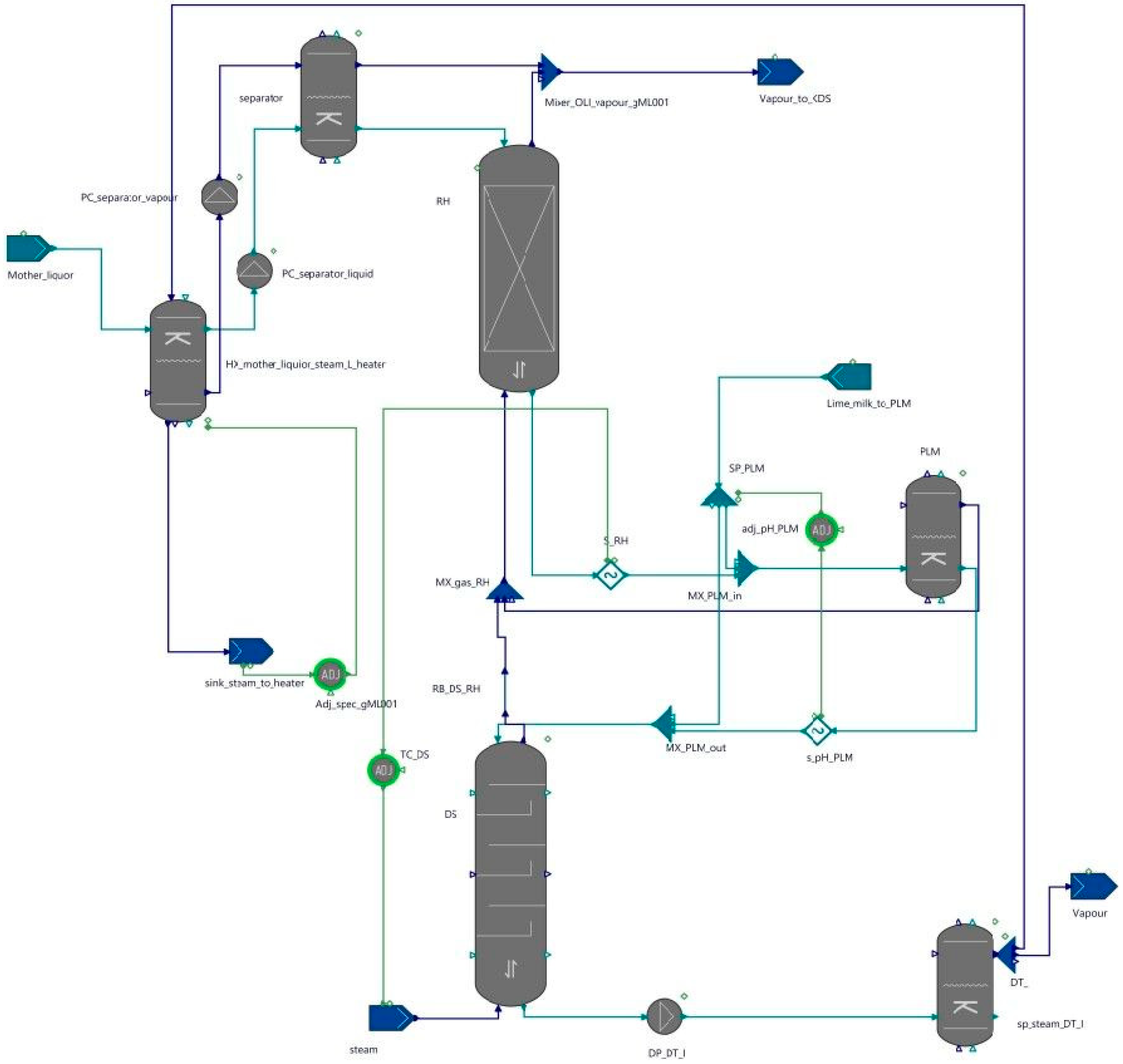
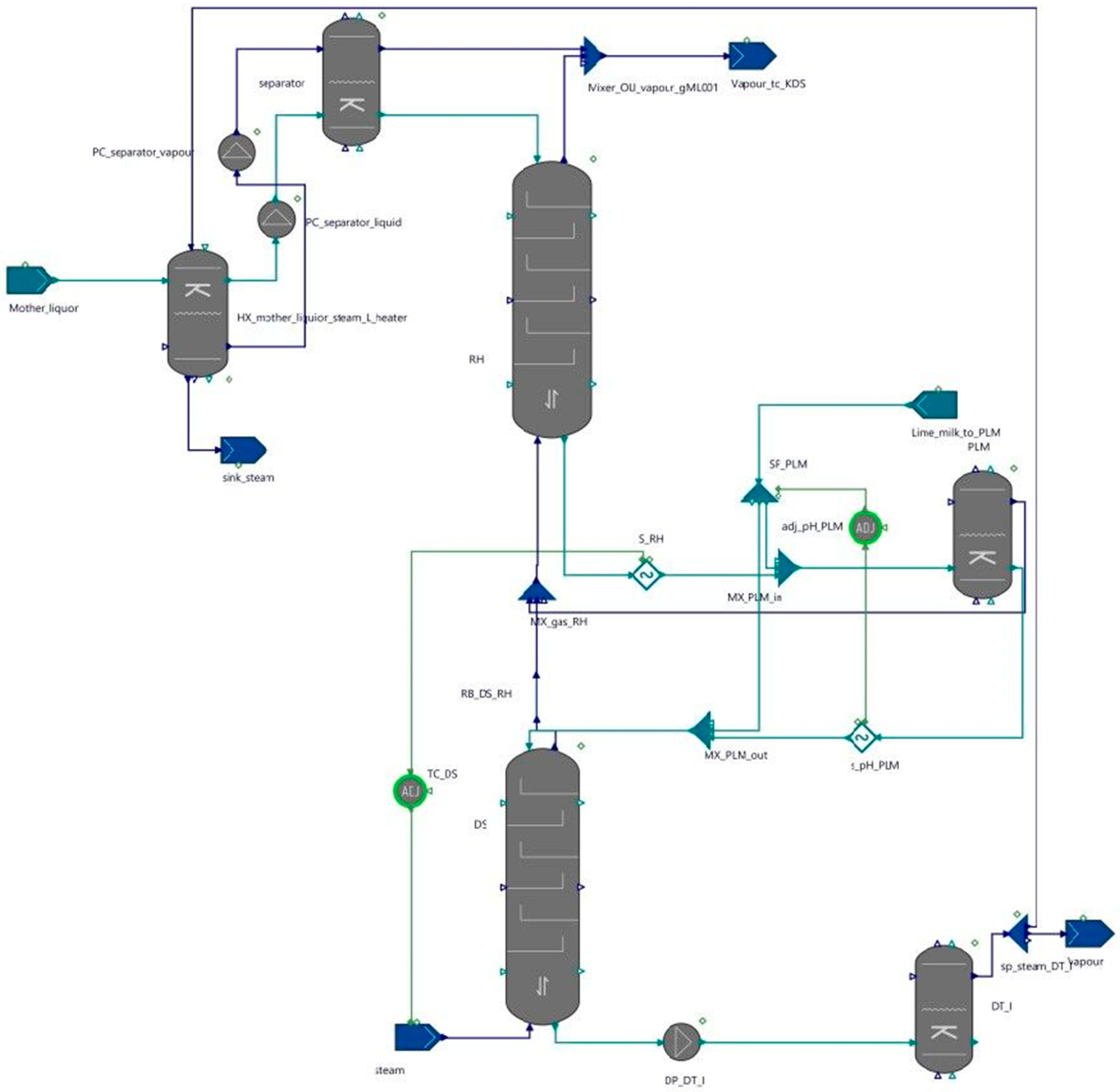



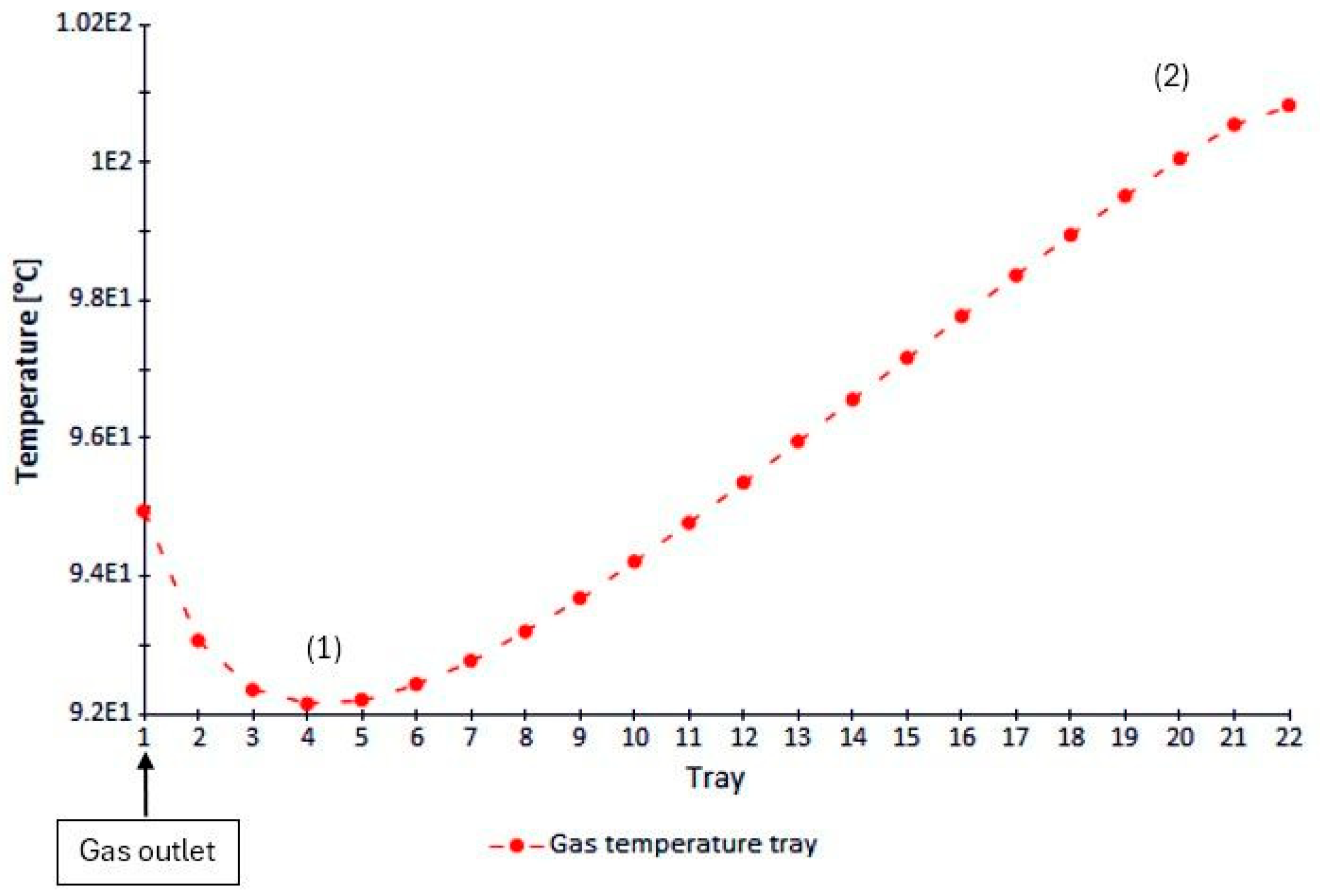
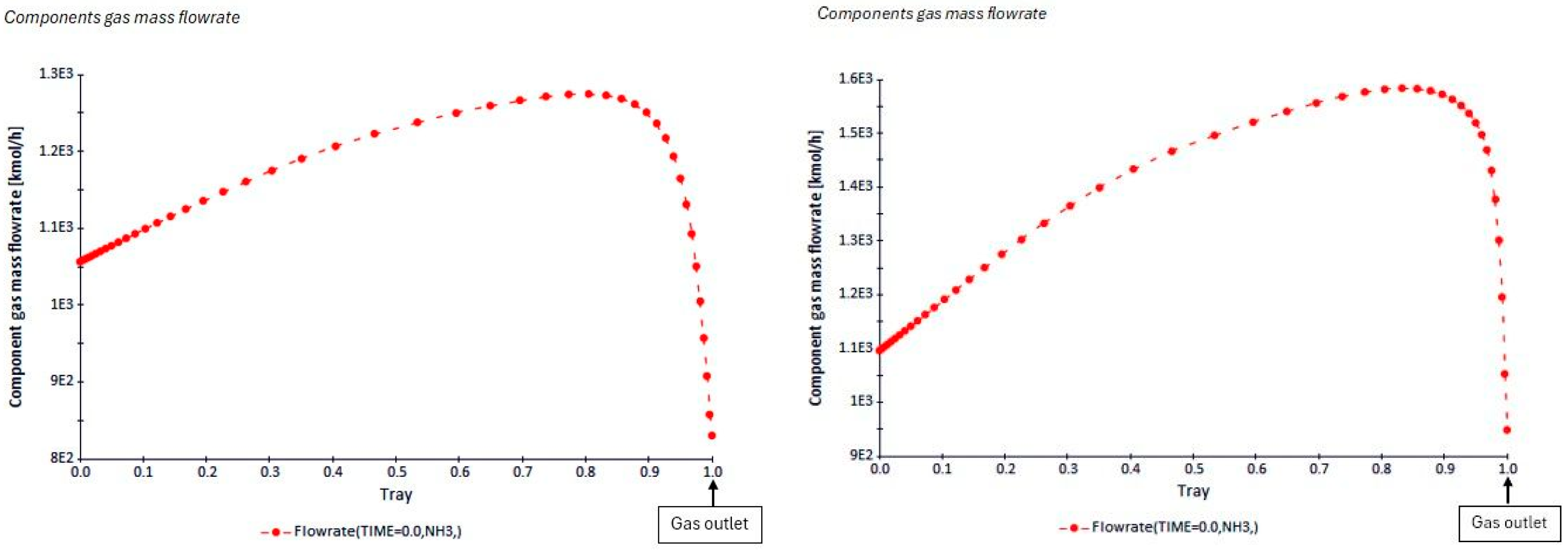


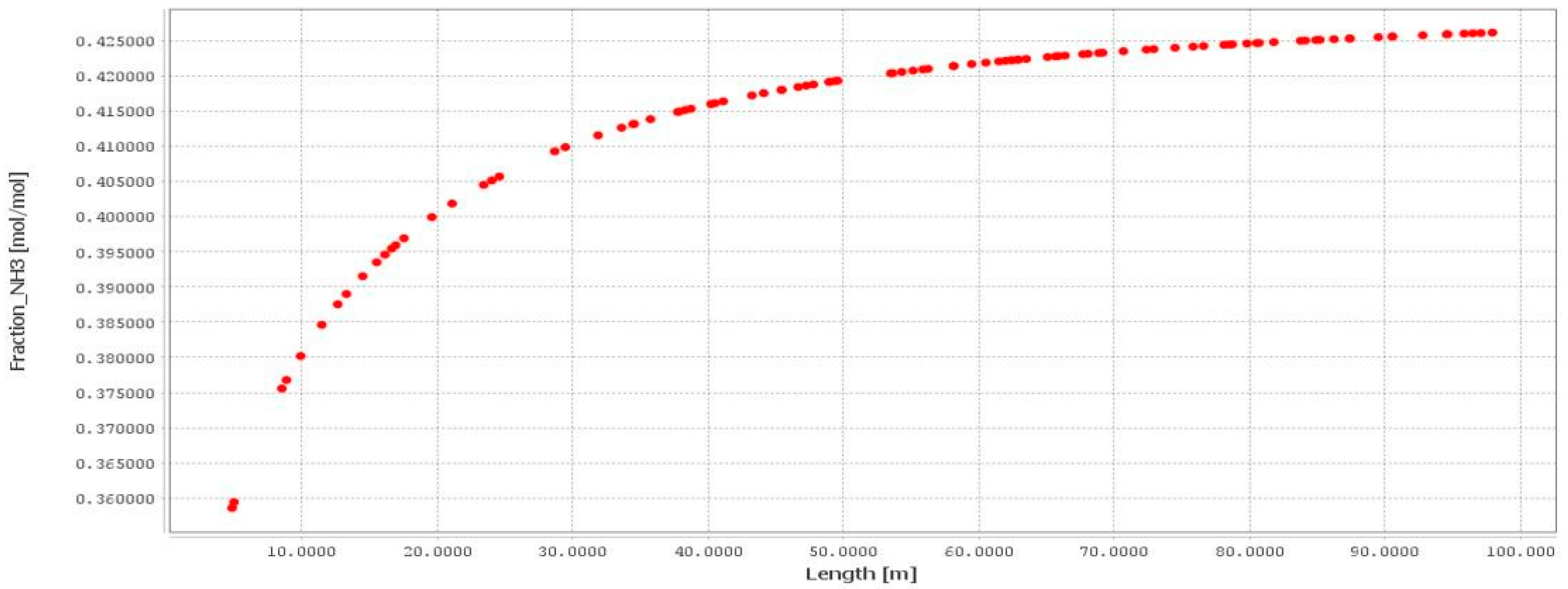
Disclaimer/Publisher’s Note: The statements, opinions and data contained in all publications are solely those of the individual author(s) and contributor(s) and not of MDPI and/or the editor(s). MDPI and/or the editor(s) disclaim responsibility for any injury to people or property resulting from any ideas, methods, instructions or products referred to in the content. |
© 2025 by the authors. Licensee MDPI, Basel, Switzerland. This article is an open access article distributed under the terms and conditions of the Creative Commons Attribution (CC BY) license (https://creativecommons.org/licenses/by/4.0/).
Share and Cite
Szczeblewski, S.; Wachowiak, M.; Gębicki, J. Optimizing Large-Scale Inorganic Processes: Model-Based Digital Design of RH-DS Apparatus. Processes 2025, 13, 77. https://doi.org/10.3390/pr13010077
Szczeblewski S, Wachowiak M, Gębicki J. Optimizing Large-Scale Inorganic Processes: Model-Based Digital Design of RH-DS Apparatus. Processes. 2025; 13(1):77. https://doi.org/10.3390/pr13010077
Chicago/Turabian StyleSzczeblewski, Sławomir, Maciej Wachowiak, and Jacek Gębicki. 2025. "Optimizing Large-Scale Inorganic Processes: Model-Based Digital Design of RH-DS Apparatus" Processes 13, no. 1: 77. https://doi.org/10.3390/pr13010077
APA StyleSzczeblewski, S., Wachowiak, M., & Gębicki, J. (2025). Optimizing Large-Scale Inorganic Processes: Model-Based Digital Design of RH-DS Apparatus. Processes, 13(1), 77. https://doi.org/10.3390/pr13010077






